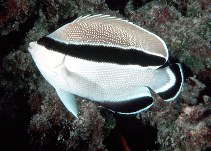
|
Apolemichthys arcuatus (Gray, 1831) Bandit angelfish |

|
|
photo by
Randall, J.E. |
| Family: | Pomacanthidae (Angelfishes) | |||
| Max. size: | 18 cm TL (male/unsexed) | |||
| Environment: | reef-associated; marine; depth range 12 - 183 m, non-migratory | |||
| Distribution: | Eastern Central Pacific: Hawaiian and Johnston islands. | |||
| Diagnosis: | Dorsal spines (total): 13-13; Dorsal soft rays (total): 17-18; Anal spines: 3-3; Anal soft rays: 18-18. Overall pale with a broad black bar bordered by a narrow pearly white band running across the upper side from the front of the eye to the posterior portion of the soft dorsal fin. A similar broad black band with pearly white border runs submarginal on the caudal and anal fins. | |||
| Biology: | Common on rocky reefs, in ledges and caves; also in coral areas (Ref. 47838). Benthopelagic (Ref. 58302). Submarine observations to 183 m (Ref. 11013). Feeds mainly on sponges (Ref. 47838); stomach content of some specimens also had algae, traces of hydroids and unidentified eggs. Minimum depth from Ref. 47838. | |||
| IUCN Red List Status: | Least Concern (LC); Date assessed: 08 October 2009 Ref. (130435) | |||
| Threat to humans: | harmless | |||